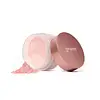Blk Cosmetics Invisible Matte Gel Powder Versus GRWM Cosmetics Powder Rush Loose Baking & Setting Powder
What's inside
What's inside
 Key Ingredients
Key Ingredients

 Benefits
Benefits

 Concerns
Concerns

 Ingredients Side-by-side
Ingredients Side-by-side

Polymethylsilsesquioxane
Dimethicone
EmollientDimethicone/Vinyl Dimethicone Crosspolymer
Skin ConditioningIsononyl Isononanoate
EmollientPhenoxyethanol
PreservativeNiacinamide
SmoothingButyrospermum Parkii Butter
Skin ConditioningChamomilla Recutita Leaf Extract
MaskingGlycyrrhiza Glabra Root Extract
BleachingCentella Asiatica Extract
CleansingRosmarinus Officinalis Leaf Extract
AntimicrobialTocopherol
AntioxidantScutellaria Baicalensis Root Extract
AstringentCamellia Sinensis Leaf Extract
AntimicrobialPolygonum Cuspidatum Root Extract
AntioxidantPolymethylsilsesquioxane, Dimethicone, Dimethicone/Vinyl Dimethicone Crosspolymer, Isononyl Isononanoate, Phenoxyethanol, Niacinamide, Butyrospermum Parkii Butter, Chamomilla Recutita Leaf Extract, Glycyrrhiza Glabra Root Extract, Centella Asiatica Extract, Rosmarinus Officinalis Leaf Extract, Tocopherol, Scutellaria Baicalensis Root Extract, Camellia Sinensis Leaf Extract, Polygonum Cuspidatum Root Extract
Ingredients Explained
These ingredients are found in both products.
Ingredients higher up in an ingredient list are typically present in a larger amount.
Dimethicone is a type of synthetic silicone created from natural materials such as quartz.
What it does:
Dimethicone comes in different viscosities:
Depending on the viscosity, dimethicone has different properties.
Ingredients lists don't always show which type is used, so we recommend reaching out to the brand if you have questions about the viscosity.
This ingredient is unlikely to cause irritation because it does not get absorbed into skin. However, people with silicone allergies should be careful about using this ingredient.
Note: Dimethicone may contribute to pilling. This is because it is not oil or water soluble, so pilling may occur when layered with products. When mixed with heavy oils in a formula, the outcome is also quite greasy.
Learn more about DimethiconePhenoxyethanol is a preservative that has germicide, antimicrobial, and aromatic properties. Studies show that phenoxyethanol can prevent microbial growth. By itself, it has a scent that is similar to that of a rose.
It's often used in formulations along with Caprylyl Glycol to preserve the shelf life of products.